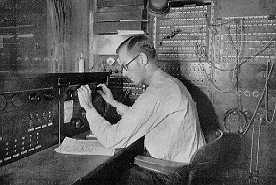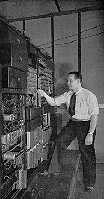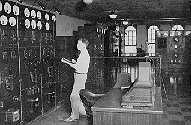|
50,000 Watts...
| You hear the voice
of the announcer, the musicians and entertainers, but you seldom hear anything
about the vast amount of machinery and electrical equipment required to send that
voice or music out to you. |
 |
In the wall of
the big studio is a double glass window. Behind this window, with hands on the
control knobs constantly, sits one of the operators. He watches what is going
on, gets signals from the announcer, switches microphones on or off, softens the
music if it comes too loud, or turns on more power if the speaker's voice is too
soft.
A little needle
on a gauge flutters back and forth registering every tone of the announcer's voice,
and if there is some unusual sound---like dropping a cowbell on the floor-the
needle jumps across its dial. The operator must be ready with the controls.
The pictureon the left was taken while the Indiana State Fair broadcast was in
progress, and while Andy handled the knobs, Charley Nehlsen was talking by code
telegraph with the operator at Indianapolis. |
 |
In the picture
at the left, Charley Nehlsen (Nelly) is talking by telegraph to a remote control.
Below on the right, William T. Anderson (Andy) is watching a "continuity"
to see what comes next.
Every mechanical
detail about broadcasting must be exact; nothing can be left to chance. Before
every program, many times a day, microphones are tested, power lines checked,
apparatus examined. Where there are delicate electrical connections by tens of
thousands, and a program going to millions of listeners, there must be no delays
nor accidents. |
| WLS
operators have many peculiar tasks, and they must handle unique broadcasts. Both
Tommy Rowe and Charley Nehlsen served their apprenticeship as radio operators
on the high seas. Rowe tells of his first trip on the salt water---a mere boy-handling
the "graveyard watch" when there was a violent storm, the ship broke
its steering gear, and in the small hours of the morning with seas breaking over
and frightened passengers buckling on life belts, his trembling fingers had to
tap out the SOS. He spent five years on the water, sailing the seven seas. Tommy
is still under 30 years of age, but an old-timer in radio. It would take a couple
of earthquakes to get him excited now |
 |
 |
At the left, chief
Engineer Tommy Rowe is inspecting a few of the thousands of electrical connections.
Right, a glimpse in the big sending station at Downers Grove, where the program
takes the air. |
 |
Comments
or suggestions? click
here to send them to Rich Samuels
Created by
Rich Samuels (e-mail to rich@richsamuels.com)
|